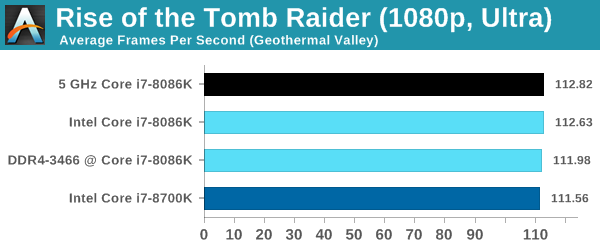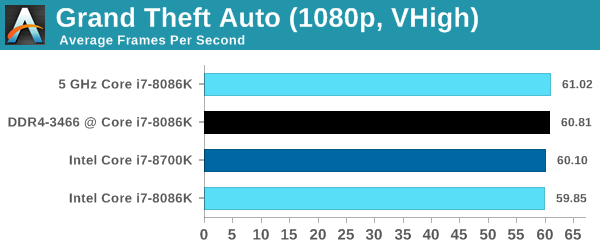The Intel Core i7-8086K Review
by Ian Cutress on June 11, 2018 8:00 AM EST- Posted in
- CPUs
- Intel
- Core i7
- Anniversary
- Coffee Lake
- i7-8086K
- 5 GHz
- 8086K
- 5.0 GHz
Overclocking Performance: GPU Tests
In the third page of the review we showed our overclocking results, with our CPU managing to hit 5.1 GHz stable with a sizeable increase in voltage. 5.1 GHz was also high in temperatures, so for our benchmark suite, we dialed back to 5.0 GHz and run a number of our tests again at this fast speed. We also ran some benchmarks at stock frequency but with increased DRAM frequencies. We initially ran the DRAM in our ASRock provided system at DDR4-3466, slightly overclocked beyond its DDR4-3200 sticker value.
For this page (and the next), we’ll show the overclocked results of the Core i7-8086K using the fast memory kits as well as the 5.0 GHz overclocked setting (at base memory). The Core i7-8700K numbers are also included for reference.
Civilization 6

Shadow of Mordor

Rise of the Tomb Raider

Grand Theft Auto V

There's not much to say with our GPU testing since we ended up being GPU-bound most of the time against the Radeon RX 580. In a more CPU-limited scenario overclocking should help, but these aren't it. Though at some point I'd like to dig into Civilization 6 turn times with the 8086K, as that stands to prove more impactful.










111 Comments
View All Comments
ipkh - Monday, June 11, 2018 - link
The multiplier chart doesn't make sense.The single core is 5Ghz, but Intel is quoting 4.7 Ghz all core and you're showing 4.4 identical to 8700K. I understand the base frequencies are the same, but the default multiplier for the 8086K should be higher. Is this a possible bios glitch or is the multiplier chart in the CPU not correct?
Hxx - Monday, June 11, 2018 - link
Boost frequencies are all the same on 5 cores. there is a youtube video with somebody testing this chip on a z370 gaming 7 and you can clearly see in that video that boost is the same on all cores except 1. Intel = lame.Ian Cutress - Monday, June 11, 2018 - link
Where is Intel promoting 4.7 GHz all core?HStewart - Monday, June 11, 2018 - link
One thing that is strange is the name - the Original IBM PC that started this whole PC industry used the intel 8088 processor and not the Intel 8086 processor. The difference is that 8088 has 8 bit external and 8086 has 16 bit external - But CPU's used 16 bit internally. No internal Floating processor until the 386 line.But it wild that it been 40 years - I have an original IBM PC - in my downstairs closet, I remember while at Georgia Tech - putting a 2Meg Ram card into and booting up to 1.4Meg ramdisk and loading Microsoft C 3.0 compiler on it.
As for new one - it would be cool if they actually included the original chip also as part of collectors edition.
AsParallel - Monday, June 11, 2018 - link
8088 shipped in 79, was a variant of the 8086. 8086 was the first to 1M transistorspeevee - Monday, June 11, 2018 - link
"No internal Floating processor until the 386 line."486. 386 still used 387 AFAIR. There were even 487, but it was just renamed 486 to be installed with 486SX.
HStewart - Monday, June 11, 2018 - link
Yes I forgot that - the 486 was the one with Math Coprocessor.AsParallel - Monday, June 11, 2018 - link
Addition. The 8087 was the floating point coprocessor for the 8086/8829a - Monday, June 11, 2018 - link
You didn't put 2mb of RAM in an original IBM PC it supported 256kb max.HStewart - Monday, June 11, 2018 - link
I had a special card in the PC - it was EMS memory - that could also fill up the main system memory to 640kb - instead of normal cache mode use by the card - I configured it as ram drive. Memory above 640Kb was directly accessible by the system.